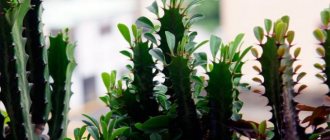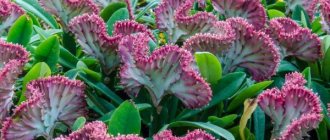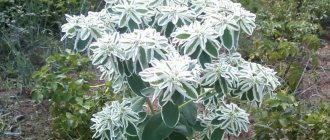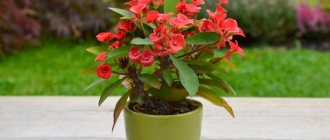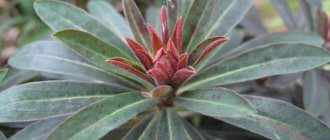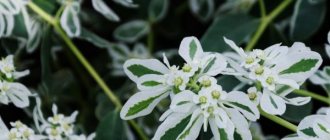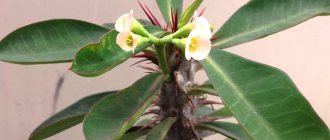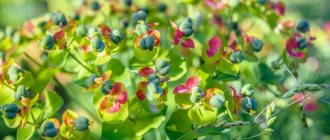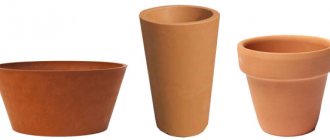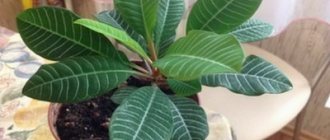Euphorbia (Euphorbia) is a large genus of annual and perennial plants of the Euphorbiaceae family. It is represented by herbs, trees, shrubs, and succulents. It is difficult to give a general description of milkweeds, since different species can differ significantly from each other. They can be deciduous, leafless, with or without thorny stems. A common feature of all euphorbias is the presence of white milky sap. The plant comes from the tropics of America, Africa, the Arabian Peninsula, and the Canary Islands.
The name “euphorbia” was given to milkweed by the Roman physician Dioscarides in honor of his colleague Euphorbus, who knew how to make medicinal products from this plant. Today, many types of milkweed have become widely cultivated at home. There are many people who want to grow it. But to grow a healthy, attractive plant, you need to know what conditions are suitable for it.
Types and varieties of milkweed for growing at home
According to various sources, the genus of Euphorbia has 800-2000 species. Only a small number of them can only grow in the wild. Many species have become quite successfully cultivated as indoor flowers. The most common types of indoor milkweed are described below.
Bordered
An annual plant that grows to 0.7-0.8 m in height. Has erect stems. Oval-shaped leaves up to 4 cm in length. During flowering, a white border appears along the edge of the leaves.
Belozhilkovy
A herbaceous perennial native to Madagascar. In nature it grows up to 1.5 m. The root system is taprooted and grows deep into the soil. The young shoot is single, the older one is weakly branched. At the bottom, the stem is woody and cylindrical. At the top it becomes five-ribs. The leaves are petiolate, have an obovate shape, and are arranged alternately in a spiral. Gradually they die off and remain only at the top. Petioles are greenish-red. The front surface of the leaves is green with distinct whitish veins; on the back they are pale green.
Trihedral
A branching succulent up to 2 m high, native to South-West Africa. The stems grow strictly vertically. The leaves are ribbed, with 3 flat edges. On their tops there are many red-brown spines that look like claws. In the axils of the thorns there are small fleshy leaves 3-5 cm long.
Comb
An evergreen succulent shrub native to Mexico. The stem is thick, ribbed, and looks similar to white-veined milkweed. The leaves are elongated, oval, located on red-brown petioles at the top of the plant. The color of the bracts is white-pink.
mile
It is also called spurge spurge. This is a highly branched succulent native to Madagascar. The stem is lumpy and grayish in color. It contains many thick conical needles up to 3 cm long. The leaves are elliptical or obovate, with short petioles. From below they die off over time and remain only at the top. The color of the flowers can be different (white, yellow, pink, orange). The bracts have a large bend.
Beautiful or Poinsettia
One of the most beautiful species comes from Central America. Poinsettia is a tall, highly branched shrub with thin, angular stems. The leaves are oval-pointed or lanceolate with jagged edges up to 16 cm long. Their surface is leathery-rough with raised veins. The bracts are large and bright, resembling leaves in size and shape. The original species has red bracts.
Natural habitat
Favorable for such types of milkweed as marsh, steppe, spicy and for weeds.
Euphorbia weed
It is a herbaceous annual. Its stem is quite juicy. It reaches a height of a quarter of a meter. Flowering begins in early summer and ends in autumn. The bell-shaped inflorescences are colored in shades of red. Grows in European and Asian countries.
Bolotny
This is a herbaceous perennial spurge, reaching a height of half a meter to a meter. Its stems are straight with an abundance of oblong leaves. The inflorescences resemble an umbrella. Distributed mainly in semi-deserts and temperate climates.
Euphorbia steppe
In the Russian Federation, steppe spurge can be seen on the banks of the Volga and Don, on the Caucasian slopes. In Ukraine, it grows in forest-steppe and steppe zones. Prefers limestone and chalk soils. It is a herbaceous perennial with an erect stem. Flowering lasts all summer.
Euphorbia acute
Also from the category of herbaceous plants. It blooms with small yellowish flowers. It is very tenacious and can adapt to any soil. Regenerated from the smallest root. It is extremely dangerous because it sucks out nutrients and moisture from the soil, depriving others of this advantage. It is quite difficult to eradicate it.
Next you can see the types of street milkweed in the photo:
Home care
Since there are so many varieties of milkweed, most of them have their own care requirements. There are no general rules of agricultural technology for this crop. But given that most indoor euphorbias are succulents, their care will be appropriate.
Location and lighting
This plant loves light very much. The most suitable place is windows facing south, south-west and south-east. But if the scorching sun penetrates through the glass, it is better to shade the plant so that it does not get burned.
In the summer, you can take the spurge outside. It is important to protect it from drafts and precipitation. If there is insufficient lighting, the crop will grow slowly, the leaves will lose their brightness and contrast. In winter, it is necessary to provide additional lighting so that daylight hours last about 10 hours.
Soil and drainage
Euphorbia should grow in loose, well-permeable soil. You can buy ready-made substrate for succulents and cacti or prepare it yourself.
For the soil mixture you will need:
- leaf soil;
- sand;
- peat;
- turf.
Take all components in equal parts. But the bottom of the pot is laid with drainage made of expanded clay or pebbles.
Planting and transplanting
Euphorbia tolerates transplants well. They give him new strength for development. Young plants are transplanted into a larger container annually. Adults - once every 3-5 years. The older the crop becomes, the less often it needs to be replanted. The procedure is best carried out in the spring.
Algorithm of actions:
- Prepare a new pot. Place drainage in it, sprinkle a thin layer of soil on top.
- Remove the spurge from the old pot without damaging the root system.
- Remove damaged leaves and stems. Place together with a lump of earth in a new pot. Cover the voids with soil.
- Water the plant and place it in a shaded place for a while until it takes root.
Step-by-step video - instructions for replanting Euphorbia:
Air temperature and humidity
During the growing season, spurge grows best at a temperature of +20..25 degrees. Flowering species need rest in winter to gain strength for future flowering. Therefore, they should be kept at a temperature of about +14 degrees. Most species are quite tolerant of temperature changes. But at the same time they are very afraid of drafts. Therefore, you need to be very careful when ventilating the room where the crop is growing.
Euphorbia is unpretentious to air humidity. It develops quite normally in the humidity conditions that are typical for city apartments.
Feeding and fertilizers
As a rule, in nature, spurge grows in poor soils. Therefore, there is no need for frequent feeding. Excess mineral salts can harm the plant. Fertilizing can be applied in the spring and summer, when the crop is growing intensively. For deciduous species, universal complex fertilizers are used, for succulent species - compositions for cacti and succulents. In spring they are applied once a month, in summer - 2 times a month. The dosage must be kept to a minimum. There is no need to feed spurge during the dormant period.
Watering
The rule for milkweed is that the more similar it is to a succulent, the less often it needs to be watered. It is important to monitor the condition of the soil. If it dries by ¼, then the plant can be watered. Liquid should not stagnate in the soil. This will lead to souring and rotting of the roots. This is especially important for species with a fleshy, thick stem. For some species, overdrying the earthen coma is very destructive (for example, for milkweed Mil). In winter, if the crop is kept cool, the amount of watering is significantly reduced.
Bloom
All flowering representatives of the genus have a similar inflorescence shape. They have a sympodial growth feature. The young part, similar to a flower, grows directly from the old one. Each such flower is a fusion of 1 apical pistil without petals and 5 separate stamens. It is surrounded by bracts, which are also left over from degenerate flowers. After flowering, a three-dimensional box remains in which 3 seeds-nuts ripen.
Trimming
After the end of flowering, Mil's milkweed has its tops trimmed to form a bushier crown. Dry shoots also need to be removed. Strong, powerful stems that will bloom next year do not need to be pruned.
Virulence
Milkweed sap is very toxic.
Once in the body, its poison causes poisoning. On the skin it causes burns and irritation. Warning! All work with the plant should be carried out with gloves. If juice gets on your skin, wash it off immediately with plenty of water. In the house, the plant should be out of reach of children and animals.
Features of watering
During the growing season, poinsettia should be watered abundantly, but without fanaticism. There is no need to do this too often either. The indicator will be fairly dry soil. Excess moisture can harm the plant. If you add too much water to the pot, the roots will rot. Let the liquid drain, and then drain it from the pan.
During the dormant period, spurge needs water less and less frequently. Therefore, between waterings it is necessary to thoroughly dry the top layer of soil. It is also worth considering that roots rot much faster in cool weather. Therefore, you need to pour water into the pot very rarely.
Reproduction methods
Indoor spurge can be propagated in several ways.
Cuttings
Cut a shoot about 10 cm long. Remove the lower leaves. Rinse off the released juice under running water. Treat the cut with charcoal. Let the cuttings dry a little and plant them in damp sand. Cover with a transparent container on top. The sand must be kept moist at all times. Avoid direct sun exposure to cuttings. After rooting, transplant the plant into a separate pot with a suitable substrate.
Seeds
Euphorbia is a dioecious plant. Therefore, to get seeds, you need to have male and female specimens at home. During flowering, perform artificial pollination; the crop is not adapted to self-pollination.
After collecting the seeds in the fall, they must be distributed over the surface of the peat-sand substrate. Cover the crops with glass and place in a warm place. After several true leaves appear, plant the seedlings in individual pots with soil intended for adult plants.
Dividing the root
This method is usually used for spurge spurge. At the end of spring or early autumn, remove the plant from the pot and inspect the roots. Carefully trim off damaged and rotten areas. Divide the stems and roots into sections. It is better to do this with your hands, without using sharp tools. If you cannot do without it, you must first disinfect it and treat the cut areas with charcoal. Plant the bushes in separate pots. Place in a shaded area until the plant takes root. This method of propagation is stressful for milkweed. Therefore, the first year after the procedure it will develop very slowly and bloom sparingly.
Care errors and their elimination
Frequently encountered problems when growing Euphorbia and their solutions:
| Problem | Causes | Solution |
| Yellowing of leaves in summer | Stagnation of moisture in the soil, draft | Water the plant moderately, avoid exposure to drafts |
| Brown spots on shoots | Sunburn | Shade spurge from the scorching sun |
| The stem is too stretched | Poor lighting | Move the flowerpot to a bright place |
How to deal with it?
Attention! In the spring, the period of combating milkweed begins. And, unlike other weeds, it requires a special approach.
There are two main ways to control the plant:
- mechanical;
- chemical.
It is more effective to use two methods in combination. In the fight against grass, gardeners have learned to use folk remedies (for example, boiling water or decoctions) and modern drugs. Sometimes you have to expect results within 1-2 years.
It is not recommended to cut grass with a mower. All roots will remain in the soil and will soon make themselves felt. By the way, mowing has a beneficial effect on ordinary grass; its root system is only further strengthened. Over time, the plant begins to capture new territories.
Diseases and pests, control methods
With improper watering, lack of lighting and non-compliance with temperature conditions, milkweed becomes susceptible to various diseases and pest invasions. Fungal infections (root and gray rot, powdery mildew) become a common problem. If infected, the plant must be removed from the pot and damaged parts removed. Treat with a fungicide (for example, Fitosporin) and replant into a fresh substrate. To prevent re-infestation by fungi, you need to regulate the care of milkweed.
Plant pests:
- mealybug;
- scale insect;
- aphid;
- spider mite
At the initial stage of infection, you can treat the bush with a soap solution. In serious cases, it is better to use insecticides:
- Aktara,
- Fitoverm,
- Decis,
- Karbofos,
- Aktellik and others.
Euphorbia in the house: benefits and harm
Traditional medicine has long used spurge to treat many diseases. It is part of many products that help cope with:
- deprived;
- anemia;
- impotence;
- eczema;
- worms;
- cystitis and other problems.
On an industrial scale, the plant juice is used to make homeopathic remedies. Euphorbia infusion is effective as a laxative, diuretic, anti-inflammatory, and immunostimulating agent. The medicinal properties of milkweed are explained by the presence in its composition of vitamins, alkaloids, resins, coumarin, and amorphous gum. They are most concentrated in the plant during the flowering period.
Any compositions with milkweed should be consumed only under the supervision of a doctor. It must be taken into account that milky juice is toxic. And unauthorized use of any formulations that contain it can lead to serious consequences.
Indoor spurge is a common plant for indoor growing. It has many varieties that differ significantly in appearance. Therefore, every gardener can choose milkweed to his liking. The main thing is to create suitable conditions for it, under which the crop will grow well and not get sick.
Want to know more useful information about growing Milkweed at home? Watch the video below:
